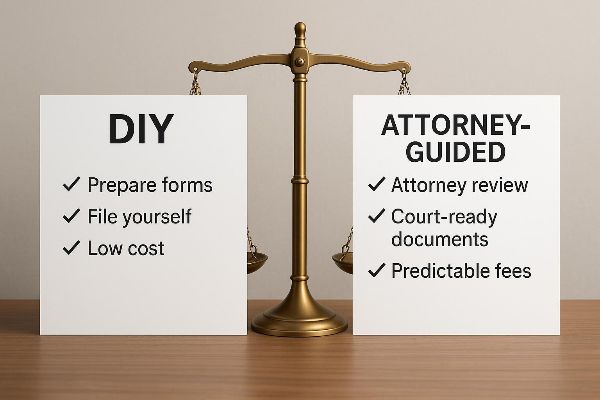What Is a Summary Dissolution (Uncontested Divorce) in Oregon?
For couples who meet specific criteria, Oregon offers a summary dissolution process – essentially the simplest form of divorce. This process is available when a marriage is relatively short and uncomplicated, allowing couples to dissolve the marriage without the full, formal procedure of a standard divorce. Summary dissolution is a type of uncontested divorce, but with even tighter eligibility rules set by Oregon law.
ORS 107.485: Eligibility Criteria for Summary Dissolution
Under ORS 107.485, a couple must satisfy all of the following conditions to qualify for a summary dissolution:
- No Minor or Dependent Children: The spouses have no children together under 18 (and no children 18-20 years old attending school) from the marriage, and neither spouse is pregnant.
- Short Marriage Duration: The marriage has lasted no more than 10 years.
- Limited Assets and Debts: Neither spouse owns any real estate, and their unpaid debts are below $15,000. Additionally, the total value of personal property each party owns is less than $30,000 (excluding loans or encumbrances).
- No Spousal Support or Temporary Orders: Both spouses waive any right to spousal support (alimony) and any temporary orders (except certain protective orders).
- No Other Pending Divorce Cases: There are no other divorce or separation cases involving the marriage filed in any jurisdiction.
If any of these conditions are not met, you cannot use the summary dissolution procedure. Instead, you would need to proceed with a regular dissolution (divorce), even if it’s uncontested.
Summary Dissolution vs. Standard Uncontested Divorce
Both summary dissolution and an uncontested divorce achieve the same result: a final Judgment of Dissolution ending the marriage. However, they differ in process and scope. A summary dissolution is a streamlined uncontested divorce for those who meet the strict criteria above. Key differences include:
- Simplified Procedure: Summary dissolution uses a simplified petition and often does not require a court hearing. Once you file the papers and the required time passes, the court can sign a judgment without a formal trial.
- Waiting Period: Oregon no longer imposes a mandatory waiting period for divorce by statute, especially when spouses agree (the former 90-day waiting period can be waived). In a summary dissolution, once the documents are filed and the notice period passes, the court can finalize the divorce relatively quickly.
- Eligibility Constraints: Many uncontested divorces won’t qualify for summary dissolution because of the eligibility limits. For example, having even one minor child or owning a home means you must use the regular divorce process (though it can still be handled as an uncontested case, just with standard forms).
In contrast, an uncontested divorce (sometimes called a “stipulated general judgment of dissolution”) is available to any couple that reaches a full settlement on all issues – but it requires the full set of divorce forms and, if minor children are involved or the court requires, possibly a brief hearing or extra documentation. Uncontested divorces are still typically much faster and cheaper than contested ones, but they involve more steps than a summary dissolution.
Filing for a Summary Dissolution
If you believe you qualify, you will need to fill out Oregon’s Summary Dissolution petition and related forms. The Oregon Judicial Department (OJD) provides an official Summary Dissolution Forms Packet with instructions for eligible couples. You can find the forms and instructions on the OJD’s website oai_citation:0‡oregon.public.law – these include the petition, affidavits, and the general judgment form specific to summary dissolutions.
Steps to proceed:
- Complete the Forms: Fill out the summary dissolution petition, making sure it states that all ORS 107.485 conditions are met. Both spouses will need to sign certain forms (some forms can be signed in front of a notary or court clerk as required).
- File the Petition: File the completed forms with the circuit court clerk in the county where either spouse lives. A filing fee (around the same cost as a standard divorce filing) will apply.
- Serve or Notify the Spouse: If only one spouse is the petitioner, the other spouse (respondent) must be officially served with the papers, just like a normal divorce. If you filed jointly as co-petitioners, formal service is not necessary.
- Waiting Period & Judgment: After filing, Oregon law might require a short waiting period or notice period before finalizing the summary dissolution. (In some cases, this is approximately 30 days after service, giving the respondent time to respond or request a hearing.) If no hearing is requested and everything is in order, the court can sign the General Judgment of Summary Dissolution to finalize the divorce.
Because the requirements are so strict, relatively few couples qualify for summary dissolution. However, if you do qualify, it can be the fastest and simplest path to divorce. If you don’t qualify, you can still proceed with an uncontested divorce using the standard process.
Making the Right Choice
Choosing summary dissolution versus a regular uncontested divorce depends on your circumstances. Summary dissolution is ideal for a very short marriage with no children and minimal assets or debts. It saves time with fewer forms and typically no court appearance. On the other hand, if you have children, significant property, or need any support orders, you will go through the standard uncontested divorce route.
Even in a simple divorce, it’s wise to ensure all paperwork is completed accurately. Mistakes in the filing can cause delays or court rejections. Many Oregonians seek legal assistance to navigate an uncontested divorce efficiently. For instance, the Pacific Family Law Firm’s uncontested divorce services help ensure that all requirements are met and documents are properly prepared. Additionally, Oregon now offers innovative platforms like Unlink Legal – an attorney-authored online service – which can assist you in preparing court-ready divorce documents for uncontested cases. By using these resources or professionals, you can confidently proceed knowing that even the “simplest” divorce is handled correctly from start to finish.













